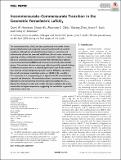Incommensurate-commensurate transition in the geometric ferroelectric LaTaO4
Abstract
The layered perovskite LaTaO4 has been synthesized to be stable in both (polar) orthorhombic and (nonpolar) monoclinic polymorphs at ambient conditions. Although the structural transition between monoclinic and orthorhombic phases has been well established, there is some controversy regarding a further, unidentified transition around 500 K. Here this is identified as an incommensurate–commensurate first‐order transition between incommensurate Cmc21(α00)0s0 and commensurate Cmc21 orthorhombic phases. Transmission electron microscopy indicates partially ordered stacking of different structural units in a, identifying the local cause for the modulation, whereas variable temperature powder neutron diffraction has shown the overall macroscopic modulation vector, q ≈ (0.456, 0, 0)—roughly a 2.2 × expansion in a, corresponding to an approximate 11a commensurate superunit cell dimension. The modulation shows a continuous temperature dependence until transitioning to the basic (commensurate) cell at TIC‐C. Doping the interlayer La sites with smaller Nd cations stabilizes the incommensuration to higher temperature, suggesting the modulation is geometrically driven at the A site.
Citation
Howieson , G W , Wu , S , Gibbs , A S , Zhou , W , Scott , J F & Morrison , F D 2020 , ' Incommensurate-commensurate transition in the geometric ferroelectric LaTaO 4 ' , Advanced Functional Materials , vol. 30 , no. 45 , 2004667 . https://doi.org/10.1002/adfm.202004667
Publication
Advanced Functional Materials
Status
Peer reviewed
ISSN
1616-301XType
Journal article
Description
Funding: UK Engineering and Physical Sciences Research Council (Grant Number(s): EP/P022637/1, EP/K503162/1), Science and Technology Facilities Council (Grant Number(s): RB1820307), China Scholarship Council (CN).Collections
Items in the St Andrews Research Repository are protected by copyright, with all rights reserved, unless otherwise indicated.

